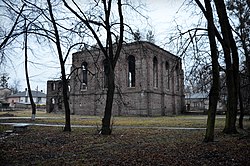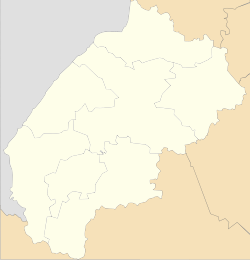| Velyki Mosty Великі Мости | |
|---|---|
| City | |
 Synagogue Synagogue | |
 Flag Flag Coat of arms Coat of arms | |
   | |
| Coordinates: 50°14′24″N 24°08′22″E / 50.24000°N 24.13944°E / 50.24000; 24.13944 | |
| Country | |
| Oblast | Lviv Oblast |
| Raion | Sheptytskyi Raion |
| Hromada | Velyki Mosty urban hromada |
| Population | |
| • Total | 6,286 |
| • Density | 7,738/km (4,808/sq mi) |
| Time zone | UTC+2 (EET) |
| • Summer (DST) | UTC+3 (EEST) |
| Website | www |
Velyki Mosty (Ukrainian: Великі Мости, lit. 'Great Bridges', IPA: [weˈlɪki moˈstɪ] ; Polish: Mosty Wielkie; Hebrew: מוסט רבתי) is a city in Sheptytskyi Raion of Lviv Oblast (region) of western Ukraine. It hosts the administration of Velyki Mosty urban hromada, one of the hromadas of Ukraine. Its population is 6,286 (2022 estimate).
History
Historical affiliations
Kingdom of Poland 1472–1772
Habsburg monarchy 1772–1918
Second Polish Republic 1918–1939
Soviet Union 1939–1941 (occupation)
Nazi Germany 1941–1944 (occupation)
Soviet Union 1944–1991
Ukraine 1991–present
In the Kingdom of Poland, the village of Mosty was a royal property, with its own starostas. The village itself was established in 1472, and was part of Belz Voivodeship in the Lesser Poland Province. In the late 15th century, Mosty was ransacked and destroyed in a Crimean Tatars raid, and in July 1497, during the Moldavian expedition of John I Albert, a unit of Teutonic Knights under Johann von Tiefen, called upon by the Polish king, marched through the village. On 23 July 1549, during the period known as the Polish Golden Age, Mosty received Magdeburg rights. It was a royal town. Following the order of King Sigismund II Augustus, a nobleman Andrzej Rokicki became the first local wójt. Mosty enjoyed several royal privileges, issued in the years 1550, 1553, 1566, 1576, 1583, 1604. The town also became the seat of a starosta.
Following the First Partition of Poland (1772), the town became part of Austrian Galicia. In 1846, a complex of military barracks was built in Mosty. In the Second Polish Republic, the Central Police Academy was located here.

The Jewish population was important in the town before World War II.
Following the joint German-Soviet invasion of Poland, which started World War II in September 1939, the town was initially occupied by the Soviet Union. In 1939, the Soviets carried out a massacre of the staff and trainees of the local Polish police academy. Afterwards, as of June 29, 1941, Germans occupied the town and kept the Jews prisoners in a ghetto using them as forced labour before murdering them all. In early July, 1941, local residents burned 19 Jews in the synagogue. Throughout the occupation, Ukrainian police assisted in most of the murders of their Jewish neighbors. The town commander, Captain Johann Kroupa in the military-engineer division of the Wehrmacht, protected Jews from death during the first part of the occupation, employing more than 2,000, including 1,200 women, and helping forge work permits for some. He was later court-martialed for protecting Jews and ended up in Soviet captivity.
Until 18 July 2020, Velyki Mosty belonged to Sokal Raion. The raion was abolished in July 2020 as part of the administrative reform of Ukraine, which reduced the number of raions of Lviv Oblast to seven. The area of Sokal Raion was merged into Chervonohrad Raion (modern Sheptytskyi Raion).
Currently, Mosty has a local branch of the Association of Polish Culture of the Lviv Land.
Population
Currently, as of 2021, the population of the town is 6,312 people.
| Graphs are unavailable due to technical issues. Updates on reimplementing the Graph extension, which will be known as the Chart extension, can be found on Phabricator and on MediaWiki.org. |
| Year | Population | Change |
|---|---|---|
| 1880 | ~4,000 | ~ |
| 1890 | 3,565 | -10.87% |
| 1959 | 3,789 | +5.91% |
| 1970 | 3,920 | +3.46% |
| 1979 | 4,516 | +15.2% |
| 1989 | 5,494 | +21.66% |
| 1992 | 5,800 | +5.57% |
| 1998 | 6,100 | +5.17% |
| 2001 | 5,925 | -2.87% |
| 2003 | 5,877 | -0.81% |
| 2004 | 5,882 | +0.08% |
| 2005 | 5,894 | +0.2% |
| 2006 | 5,934 | +0.69% |
| 2007 | 5,960 | +0.44% |
| 2008 | 5,971 | +0.18% |
| 2009 | 5,996 | +0.42 |
| 2010 | 6,010 | +0.23% |
| 2011 | 6,037 | +0.45% |
| 2012 | 6,094 | +0.94% |
| 2013 | 6,121 | +0.44% |
| 2014 | 6,132 | +0.18% |
| 2015 | 6,166 | +0.55% |
| 2016 | 6,213 | +0.76% |
| 2017 | 6,224 | +0.18% |
| 2018 | 6,251 | +0.43% |
| 2019 | 6,298 | +0.75% |
| 2021 | 6,312 | +0.22% |

Notable people
Among people born here are photographer Wlodzimierz Puchalski, mathematician Wlodzimierz Stozek and Austrian painter Siegfried Weyr.
References
- "Великомостовская громада" (in Russian). Портал об'єднаних громад України.
- Чисельність наявного населення України на 1 січня 2022 [Number of Present Population of Ukraine, as of January 1, 2022] (PDF) (in Ukrainian and English). Kyiv: State Statistics Service of Ukraine. Archived (PDF) from the original on 4 July 2022.
- Palkov, Taras (2009). Marshruty Lvivshchynoiu na vykhidni : putivnyk (in Ukrainian). Lʹviv: Ladeks. pp. 57–60. ISBN 978-966-8233-11-1. OCLC 499369171.
- "Mosty Wielkie". Virtual Shtetl. Retrieved 24 March 2020.
- Krystyna Balicka. "Zagłada policji polskiej" (in Polish). Retrieved 31 October 2024.
- מוסטי וייֶלקֶיה [Mosty Wielkie]. Yad Vashem (in Hebrew). Retrieved 24 March 2020.
- Megargee, Geoffrey (2012). Encyclopedia of Camps and Ghettos. Bloomington, Indiana: University of Indiana Press. p. Volume II, 808–810. ISBN 978-0-253-35599-7.
- Mosty Wielkie Czarnecki, Jerzy (2006). Wiehn, Erhard Roy (ed.). My life as an "Aryan": from Velyki Mosty through Zhovkva to Stralsund (1st ed.). Hartung-Gorre. ISBN 3-89649-998-X.
- Megargee, Geoffrey (2012). Encyclopedia of Camps and Ghettos. Bloomington, Indiana: University of Indiana Press. p. 809. ISBN 978-0-253-35599-7.
- "Kroupa - United States Holocaust Memorial Museum". collections.ushmm.org. Retrieved 2023-12-29.
- "Про утворення та ліквідацію районів. Постанова Верховної Ради України № 807-ІХ". Голос України (in Ukrainian). 2020-07-18. Retrieved 2020-10-03.
- "Нові райони: карти + склад" (in Ukrainian). Міністерство розвитку громад та територій України.